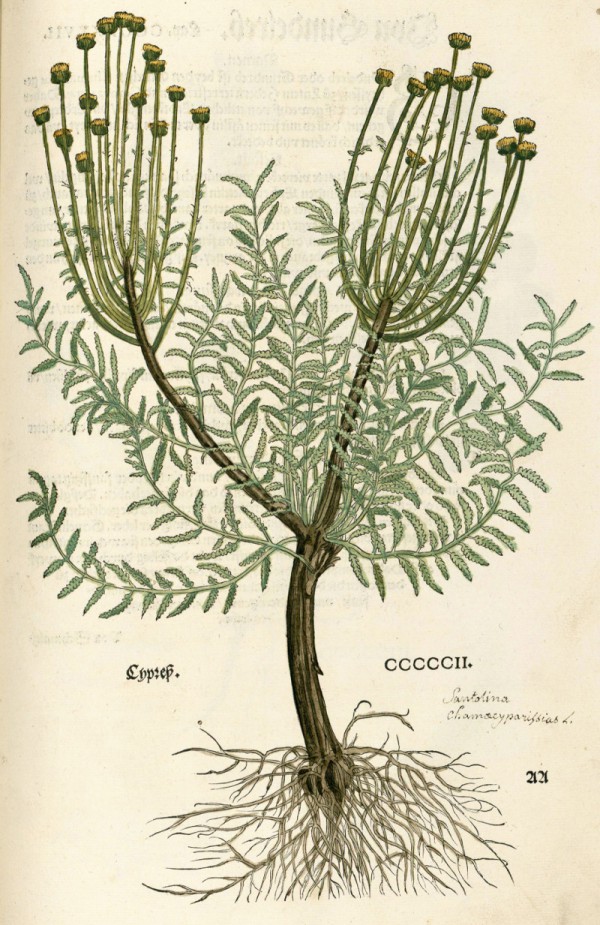Santolina chamaecyparissus L. aggr. - Asteraceae - lavender-cotton, cotton lavender, Graues Heiligenkraut
Evergreen subshrub, up to 50cm high, native to southern Europe, naturalized in Central Europe, West Asia and North America; leaves gray-green, pinnately lobed; flowers yellow.
„Cotton lavender has many potential uses. Most commonly, the flowers and leaves are made into a decoction used to expel intestinal parasites. An oil used in perfumery can also be extracted from the plant. Branches may be hung up in wardrobes to repel insects, and leaves are also suitable for use in pot pourri and in herbal tobacco substitutes. In cosmetics it is used as a tonic.“
http://en.wikipedia.org/wiki/Santolina_chamaecyparissus
„The chemical composition of an oil of Santolina chamaecyparissus has been examined by standard GC and GC/MS techniques. In addition to artemisia ketone (25-40%), other compounds possessing this artemisyl skeleton such as artemisia triene (trace), yomogi alcohol (0.8-1.2%) and artemisia alcohol (0.5-1.0%) were found in this same oil.“
[Derbesy, M., Touche, J., & Zola, A. (1989). The essential oil of Santolina chamaecyparissus L. Journal of Essential Oil Research, 1(6), 269-275.]
 artemisia ketone (fruity-chamomile, tagetes-like)
artemisia ketone (fruity-chamomile, tagetes-like)
„The essential oil of Santolina chamaecyparissus L. was analyzed by a combination of gas chromatography and mass spectrometry. The oil was found to contain over 140 constituents of which 70 were identified. The major components were artemisia ketone (ca. 45%) and myrcene (15%).“
[Volatile constituents of the essential oil of Santolina chamaecyparissus L., Vernin, G., Journal of Essential Oil Research, Vol.3(1), 1991, 49-53]
„The essential oils from several Santolina chamaecyparissus L. subspecies from wild (Spanish insular and peninsular) and cultivated (Spanish and British) populations have been examined. According to the composition of the volatiles three different groups are proposed: cultivated, insular, and peninsular samples. Artemisia ketone (27.8-35.6%) and T-cadinol (23.6-4.8%) were characteristic components in cultivated samples, whereas in the insular ones camphor (42.9%) and cubenol (17.3%) were the main compounds. Monoterpenes predominated in the essential oils of peninsular populations corresponding to subspecies incana (85.9%) and squarrosa (45.2-68.5%), of which camphor (9.2-24.9%), borneol (11.6-28.4%) and 1,8-cineole (2.3-8.7%) were the major components. Conversely, the essential oil of subspecies tomentosa was mainly composed of sesquiterpenes (61.4%), elemol (5.0%), nerolidol + spathulenol (9.3%), copaenol (15.2%), ledol (4.1%) and cubenol (6.7%) being the major components.“
[Essential oil components of Santolina chamaecyparissus L., Pérez‐Alonso, M.J., Velasco‐Negueruela, A., Flavour and fragrance journal, Vol.7(1), 1992, 37-41]
„Supercritical fluid extraction (SFE) of the volatile oil from Santolina chamaecyparissus L. flower heads was performed under different conditions of pressure, temperature, mean particle size and CO2 flow rate. This oil was compared with the essential oil isolated by hydrodistillation (HD). The SFE volatile and essential oils were analysed by GC and GC-MS. The range of the main volatile components obtained with HD and SFE were, respectively: 1,8-cineole (25-30% and 7-48%), camphor (7-9% and 8-14%), borneol (7-8% and 2-11%), terpinen-4-ol (6-7% and 1-4%), terpinolene (1-4% and 1-7%) and isobornyl acetate (1-2% and 1-11%). The chemical composition of the extracts was greatly influenced by the conditions of pressure and temperature used. In fact, it was possible to enrich the sesquiterpene fraction by increasing the pressure from 8 to 9 MPa, while changing the temperature from 40 to 50°C at 90 bar enriched of the volatiles in n-alkanes.“
[Supercritical fluid extraction of the volatile oil from Santolina chamaecyparissus., Grosso, C., Figueiredo, A.C., Burillo, J., Mainar, A.M., Urieta, J.S., Barroso, J.G., Palavra, A.M., Journal of separation science, Vol.32(18), 2009, 3215-3222]

Fuchs, L., New Kreüterbuch, t. 502 (1543)
http://plantgenera.org/species.php?id_species=905292

Santolina chamaecyparissus, Botanischer Garten Marburg
© Andreas Kraska, CC BY-SA 3.0